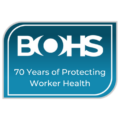The UK’s Chemical Protection Policy is Insufficiently Focused on Protecting Women
The British Occupational Hygiene Society is expressing concerns about a government announcement which may have a negative impact on women’s health. A decision about whether to act on exposure to harmful chemicals was recently announced which, the Society believes, demonstrates a lack of policy and focus on how women are impacted by chemicals at work, as well as in the home.
The Government’s publication outlines a rationale for not restricting certain substances under UK REACH, the post-Brexit mechanism for protecting people from harmful chemicals being placed on the market. Rationale for prioritising substances in the UK REACH work programme: 2023 to 2024 – GOV.UK (www.gov.uk)
The Government’s decision, which also determined that it was not a UK priority to introduce tighter regulation arising from some harmful period products, cosmetics, nappies, and textiles under the regulatory system, has deferred consideration of a series of substances that cause illness in the workplace into the long grass.
26 chemicals were under consideration for UK REACH because of serious health concerns leading to regulation in European countries. Of these, only 5 are being acted upon. Of the remaining 16 not determined to be a priority, 10 are toxic to reproduction and 6 are specifically more likely to have other health impacts on women. *
The Society is expressing concern that a common factor in the substances and products that are not deemed a priority is their impact on women or on reproduction. The UK does not have a strategy for dealing with reprotoxins, substances harmful to human reproduction, or a focus on the differing effects of workplace exposure on men and women. By contrast, the European Union includes reprotoxins as priority substances within its regulatory framework.
Following on from a report by the Society last year highlighting a hidden crisis in women’s workplace health, the scientific charity is concerned that demands on UK regulators are struggling to keep pace with advances in our understanding in diseases. This is a matter of particular concern because knowledge, understanding and research of the differential health effects on women and on pregnant workers and their unborn children are poorly understood.
“For years, our health and safety rules and regulations have been built around the model of men working in industry and frequently assumed that the risks for men and women would be the same. But workplaces have changed and the science underpinning that change has not kept pace”
says BOHS President, Alex Wilson.
“We don’t need special regulations, but at the same time, we can’t ignore the scientific evidence nor the absence of it and we need policies that follow that science.”
The Society has raised the issue of better protection of women from workplace health hazards with regulators and industry groups, but thinks the Government needs to provide a lead by having a clear strategy for tackling women’s workplace health and reprotoxins. Their call comes as the absence of suitably fitting PPE for women workers in the National Health Service has been highlighted by the ITV drama, Breathtaking.
BOHS CEO Professor Kevin Bampton adds:
Protecting unborn children from preventable illness and women workers from exposures to chemicals that affect them differently from men, would seem to be at the heart of any rational national strategy for health protection. However, the UK has no such policy. You don’t need to be an expert in equality law to read this rationale and wonder why it seems to be women and children last when it comes to UK REACH.
Notes to editors
*Of the substances not being considered a priority most have recorded reprotoxic risks, with substances like cobalt salts, widely used in electric vehicle battery manufacture, associated with gynaecological diseases. While European countries have also restricted Dimethylformamide, another reprotoxin, which is used in textiles, leather and fur industries, the UK has not listed it as a priority for further regulation.
PAHs in rubber pitches and playgrounds, which have harmful health effects are also relegated to potential future considerations, as are N,N-Dimethylacetamide and 1-ethyl-2-pyrrolidone, used as solvents or processing agents across various industrial sectors such as textile fibre manufacture, electrical wire insulation, pharmaceuticals, agrochemicals, and membrane manufacture.





